

The piano is one of the most popular and elegant musical instruments of all time. Its sound is capable of transmitting emotions and feelings ranging from joy to the deepest sadness, which makes it the perfect companion for any state of mind.
In addition, the piano is a very versatile instrument that can be used in a wide variety of musical genres, from classical to pop, jazz or rock. Its technical and musical complexity makes it suitable for both beginners and experienced musicians, as it offers endless possibilities for creating music and developing performance skills.
In this article, we’ll explore the different parts of the piano, how they work, and how to learn to play it. If you are interested in acquiring a new skill or just want to learn more about this wonderful instrument, keep reading.
history of the piano
Origins of the piano: The piano is a percussion string musical instrument, invented in Italy at the beginning of the 18th century by Bartolomeo Cristofori. The creation of it was the result of the need for an instrument that could control the volume of the sound, something that was not possible with the existing string instruments until that moment.
Piano evolution: Over the centuries, the piano has evolved and developed, from the first grand pianos to modern electric pianos. In the 19th century, virtuoso pianists such as Franz Liszt and Frédéric Chopin popularized the piano as a solo instrument and took it to new heights of complexity and expressiveness.
The piano today: Today, the piano remains one of the most popular and versatile instruments. It is used in a wide variety of musical genres and is appreciated by both professional and amateur musicians.
piano types
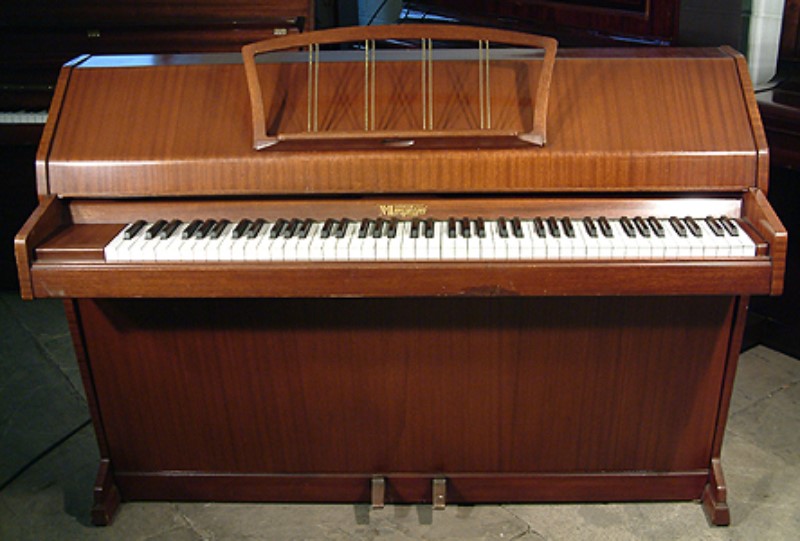
Vertical piano: Also known as an upright grand piano, it is the most common type of piano used in homes and schools. The mechanism and strings are arranged upright, making the piano more compact and easy to fit into a small space.
Grand piano: Also known as a concert piano, it is the largest type of piano used in large concert halls. The strings are arranged horizontally and the soundboard is larger, providing a fuller, more powerful sound.
digital piano: uses digital technology to emulate the sound and feel of a real piano. They are more portable, easier to maintain, and often come with additional features like the ability to record and play music.
Toy piano: Primarily designed for children and beginners, these pianos are smaller and cheaper than real pianos. They often come in fun shapes and bright colors to entice children to learn to play.
Electric piano: Also known as an electric keyboard, it uses electronics to emulate the sound of a real piano. Sound and volume settings can be adjusted and often come with additional features like the ability to connect to a computer or mobile device.
Acoustic pianos vs. digital pianos
Choosing between an acoustic piano and a digital piano depends on your personal needs and preferences. Acoustic pianos offer a more natural sound and authentic playing feel, but they are larger, more expensive, and require more maintenance. Digital pianos are more portable, cheaper, and offer a variety of additional features, but some musicians argue that they lack the authenticity and sound quality of an acoustic piano.
piano parts
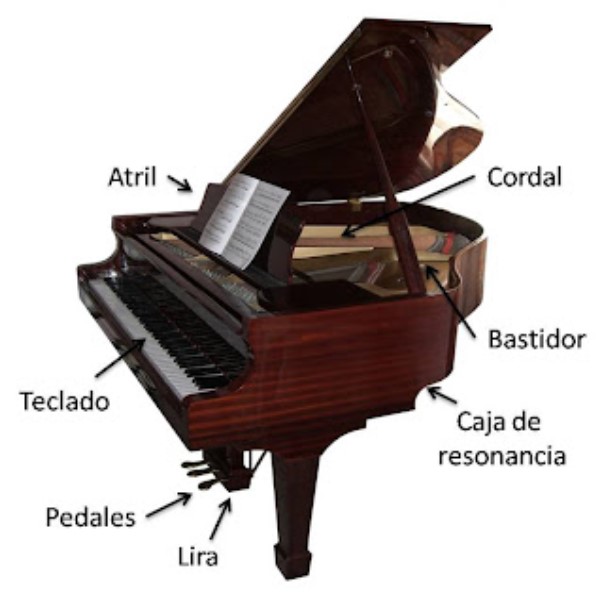
The piano is a complex musical instrument made up of several fundamental parts that work together to produce sounds. Some of the most important parts of the piano are:
Sounding board
The sound box of the piano is the place where the strings vibrate and the sound is amplified. It is made of hardwood and has a curved shape so that sound is reflected and amplified in all directions. All the parts of the piano are attached to the soundboard to create a uniform and balanced sound.
Keyboard
The keyboard is one of the most recognizable parts of the piano. It is made up of 88 keys that extend from the low notes of the piano to the highest notes. Each key is connected to a hammer that strikes the strings to produce the sound. The keyboard also has pedals that affect the sound that is produced and are used by pianists to improve their technique and musical expression.
strings
The strings are another fundamental part of the piano. The piano has 230 strings tuned to different tensions to produce different notes and tones. The strings are made of steel and are extremely thin and delicate.
The intricacy of the piano is a true testament to the skill and craftsmanship that goes into building and playing this wonderful musical instrument. Every part of the piano, from the keys to the strings, is essential in creating the beauty and complexity of the sound that comes out of the piano.
How to play the piano
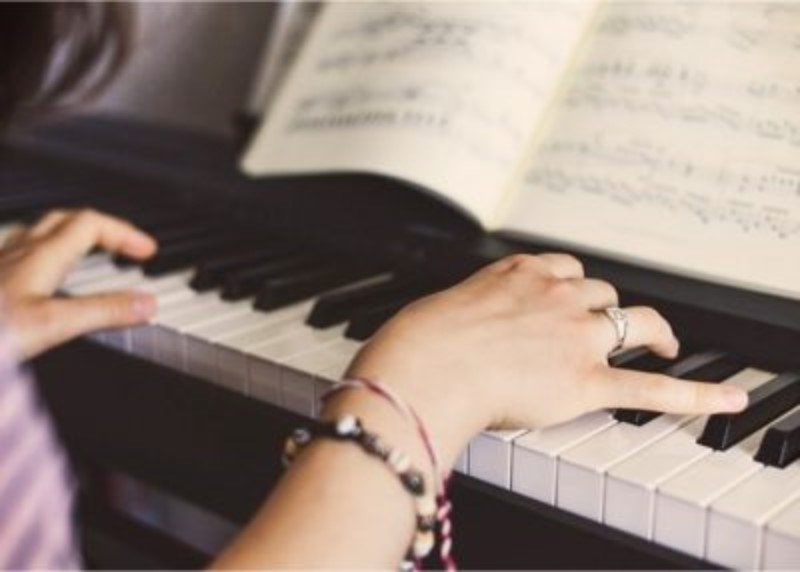
Position: To play the piano it is important to maintain a correct and balanced posture. Sit in the center of the bench and place your feet flat on the floor. The arms should be relaxed and the fingers curled over the keys. The height of the bench should be adjusted so that the elbows are at the same height as the keyboard.
Technique: Technique is essential to be able to play the piano correctly. It is important to start with warm-up exercises to relax the hand and fingers. Scales and arpeggios can then be practiced to improve technique and agility. In addition, it is advisable to have a good teacher who can correct bad postures and incorrect technique.
regular practice: To learn to play the piano you need to practice regularly. The ideal is to practice at least 30 minutes a day, but it is important not to force your hand or fingers. Regular practice will improve technique and speed.
Interpretation: Performance is an important part of playing the piano. You need to be able to convey emotions through music and have a good understanding of it. For this, it is essential to listen to other musicians and recordings, and to be able to analyze and understand the structure of the music that is being performed.
Memorization: The memorization of the pieces is a key aspect to be able to play the piano with ease and security. It is important to practice the piece until you know it by heart, which will allow you to pay more attention to performance and technique. In addition, memorization is essential to be able to play in public without sheet music.
Piano care and maintenance
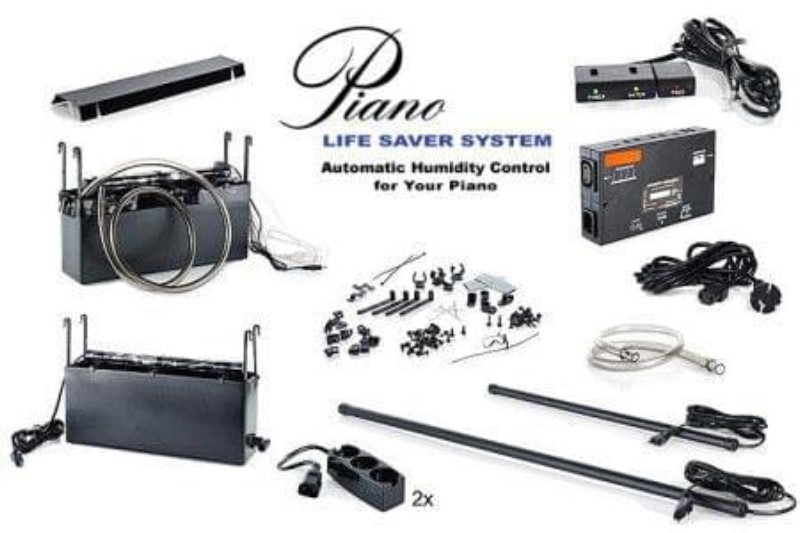
Why piano care and maintenance is important
The piano is a complex and expensive musical instrument that requires regular maintenance to maintain its sound quality and prolong its life. Proper piano care can also help prevent future expensive repairs and maintain its resale value. Even small problems like dust buildup on the keys or a change in humidity can affect the sound of the piano.
How to care for the exterior of the piano
The exterior of the piano also requires regular care. It is important to use a soft, clean cloth to remove dust and smudges from the finish. It is recommended to avoid the use of chemicals and abrasive cleaners that may damage the piano’s surface. Also, the piano should be kept out of direct sunlight to prevent discoloration of the wood.
How to care for the interior of the piano
The interior of the piano also requires attention and care. Strings, hammers and springs must be kept clean and free of dust and dirt. It is important to follow the manufacturer’s instructions for cleaning and maintaining the piano, including lubricating the action mechanism if necessary. It is also advisable to keep the piano in an environment with a constant relative humidity to prevent the wood from expanding or contracting.
Makes and models of piano
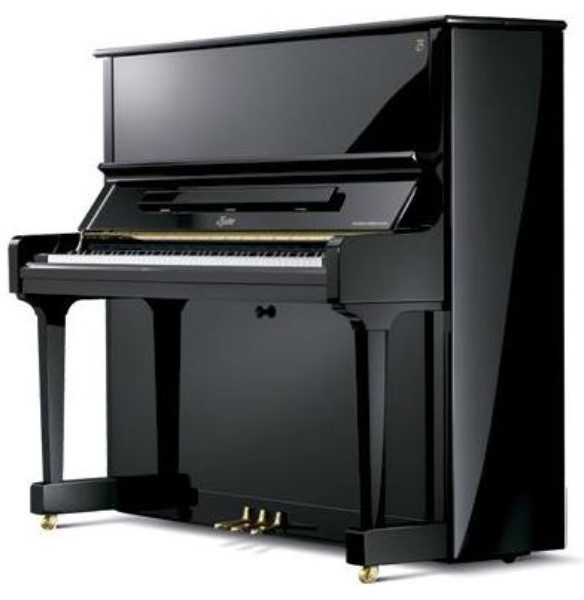
6.Piano marks
There are numerous piano brands on the market, each with its own unique style and characteristics. Some of the most recognized brands are Steinway & Sons, Yamaha, Kawai and Bosendorfer.
Steinway & Sons is known for its quality and prestige, and is one of the oldest and most recognized brands in the piano world. Yamaha offers a variety of models in different price ranges, and is a good choice for beginning pianists and those on a tight budget. Kawai is another Japanese brand that offers high-quality pianos, especially in the grand piano market. Finally, Bosendorfer is an Austrian brand that focuses on the production of handmade grand pianos made from high-quality materials.
6.Piano models
Each piano brand offers a variety of models in different price ranges and sizes. The most common piano models are upright, grand, and digital.
Upright pianos are a good option for those who are short on space in their home or on a limited budget. Grand pianos, on the other hand, have a deeper, richer sound and are ideal for advanced pianists and concert halls. Digital pianos are an affordable option for those looking for an easy-to-use and portable piano, and offer the advantage of additional features such as recording and playing music.
Buying a piano: a beginner’s guide

Buying a piano can be a significant investment, both in terms of money and space in your home. It is important to consider certain factors before making the purchase.
Upright pianos vs. grand pianos
Choosing between an upright and a grand piano will mainly depend on the space you have available. Upright pianos are more compact and suitable for smaller rooms, while grand pianos require more space and are often used in living rooms or music rooms. However, grand pianos often offer better sound quality and a greater sense of touch due to their horizontal string design.
Experience level and budget
If you’re a beginner, you probably don’t need a professional-quality concert piano. A digital piano can be a good option if you don’t have a lot of space or a limited budget, since they tend to be cheaper and take up less space. If you already have experience playing the piano or are thinking of pursuing a career in music, you may want to invest in a high-quality acoustic piano.
try before you buy
It’s important to try out your piano before you buy it, especially if it’s an acoustic piano. Spend some time playing different pianos to compare their sound and feel. If possible, bring someone experienced on the piano to help you assess the sound quality. Also, please check the physical condition of the piano and make sure it is in good condition before purchasing.
By following these tips, you will be able to make an informed decision about purchasing a piano that will meet your needs and provide years of musical enjoyment and practice.
